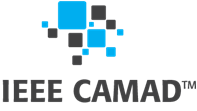CALL FOR PAPERS
Considering the ever-increasing traffic demand and required quality of service, current 4G wireless access networks will soon arrive to their “limit”. For this reason, it is foreseen that the commercial deployment of the first 5G networks will probably occur by 2020 and these will respond to a set of predefined requirements, mainly: 1) support for ultra-high capacity and massive connectivity; 2) support for an increasingly diverse set of services, applications and users, and; 3) flexible and efficient use of all available non-contiguous spectrum for wildly different network deployment scenarios. In order to respond to the above-mentioned requirements, the way is still long and important technical challenges need to be solved. Current research efforts on 5G Radio Access Networks (RAN) strongly focus on Optical/Wireless convergence, small cells (SCs) deployment, massive-MIMO and millimetre-wave (mmWave) access for addressing the critical limitations of currently deployed cellular systems. Industrial and academic institutions concur that it is of great importance to develop evolutional paradigms that can ensure the functional combination of the above technologies into a 5G cellular architecture and its associated ecosystems, providing innovative vertical services. This Workshop, co-located in IEEE CAMAD 2018, aims to offer an opportunity for academic and industrial researchers to discuss on feasible solutions including evolutional technologies and ecosystems for the realization of 5G and beyond.
Prospective authors are invited to submit original and unpublished work on research topics including the following:
- Novel 5G radio access network (RAN) architectures.
- Fiber/Wireless convergence for 5G Front/Back-hauling.
- Analog/Digital Radio-over-Fiber solutions for 5G communications.
- CoMP (coordinated multi-point) transmission and reception.
- Access control for converged hybrid Optical/Wireless networks.
- Distributed antenna systems.
- Advanced relaying, user terminal relaying.
- Small cell deployment, femtocells, picocells for dense/ultra-dense deployment.
- Terminal intelligence, Context awareness.
- Advanced radio resource management (RRM) techniques.
- Interference management, interference awareness.
- Inter-cell interference coordination (ICIC, eICIC).
- Congestion management.
- Emerging technologies in 5G physical layer.
- Interference-robust air interface.
- Higher-order massive MIMO, Active antenna systems (AAS).
- Multiuser communications, Network information theory.
- Novel modulation and coding schemes.
- Enhanced voice and video, Telepresence
- Point-to-point (P2P) / device-to-device (D2D) communications
- mmWave 5G communications.
- Channel characteristics and modelling.
- Beamforming, beam tracking; Mobility solutions.
- Energy efficiency and energy consumption models.
- Joint RF-baseband optimization, end-to-end energy optimization.
- Aggregation of intra and inter-band carriers for both FDD and TDD.
- Cognitive radio and dynamic spectrum access.
- Adaptive radio access techniques.
- Prototyping and test-bed for emerging 5G technologies.
ORGANIZERS
- George Kalfas (Aristotle University of Thessaloniki)
- Idelfonso Tafur Monroy (Technical University of Eindhoven)
- Ioannis Chochliouros (Hellenic Telecommunications Organization S.A. (OTE)
- Anna Tzanakaki (University of Bristol, UK & National and Kapodistrian University of Athens)
SUBMISSION
Manuscripts must be prepared in the standard IEEE two-column conference format with a maximum paper length of six (6) printed pages (maximum 1 additional page with over length page charge) and submitted via the provided EDAS link.
CO-SPONSORED BY PROJECTS





